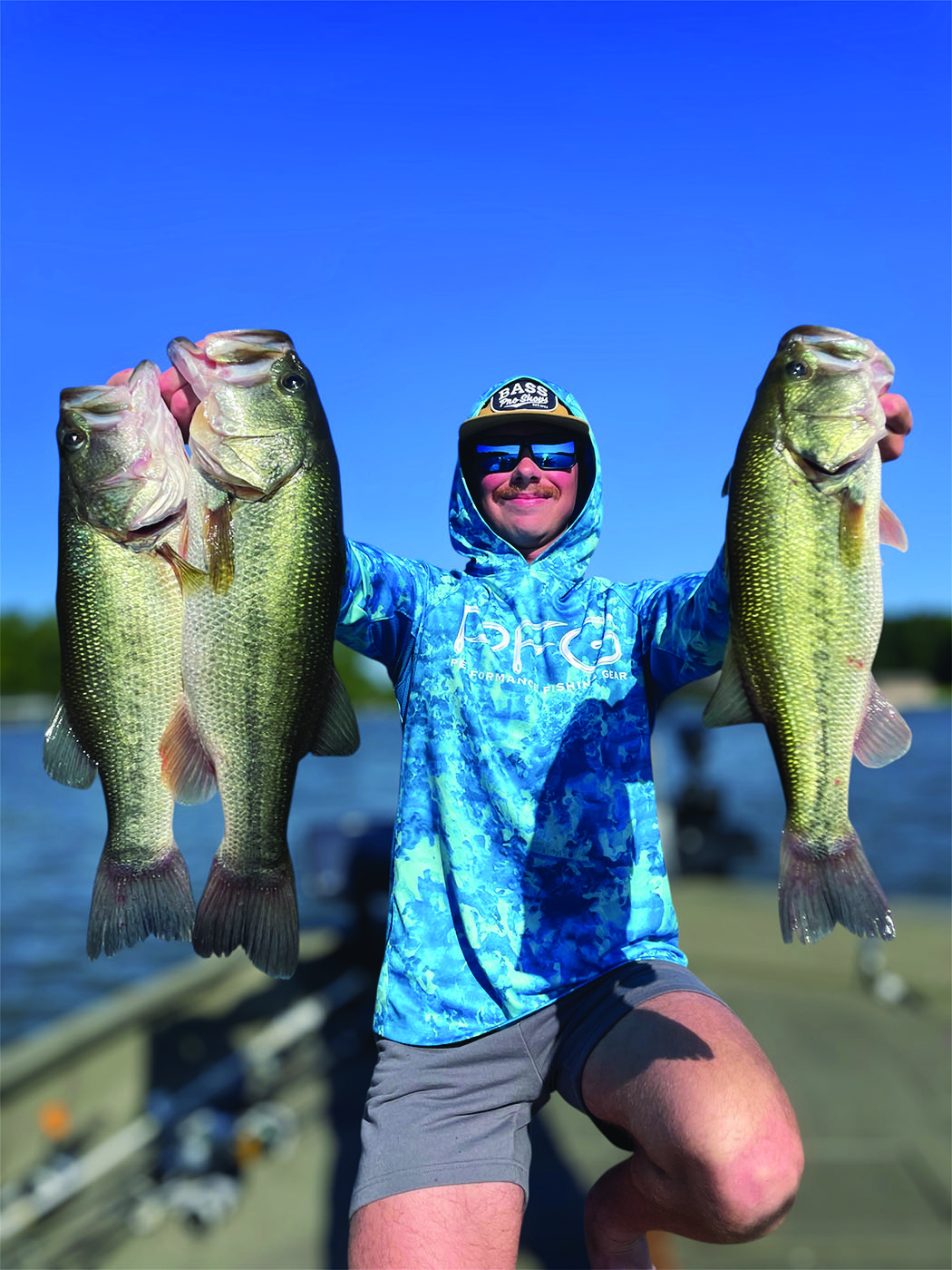Summertime in Virginia means day after day of hot, humid weather that may not be everyone’s favorite to fish in, however, this consistency is perfect for bass in rivers and lake looking to feed heavily without expending much energy. And fishing can be downright hot if you crack this summertime code. Determine where the fish are and what they are feeding on and you can pretty much rely on good fishing through August. Here are some summer fishing tips from our W2 Pro Team members, also respected guides around Virginia, that may help you on your home water or where you plan on visiting.
Tidal Potomac River
W2 Pro Team member Steve Chaconas is one of the most senior guides on the tidal Potomac River with over 30 years on the water with clients. He’s also a talented writer that pens the Hook, Line & Thinker column each month for W2. He shared his thoughts on summer bass fishing tactics on the nations’ river.
“The first thing to do is to respool line for this time of year, starting with moving baits.
For pitching jigs and swimming jigs, I spool up with 16-pound test Gamma Edge fluorocarbon that enables long casts and easy pitches while having the strength to set the hook and pull fish out of grass.”
The seasoned Potomac River guide notes he likes to use black blue, craw patterns and peanut butter and jelly ½-ounce Missile Baits Ike’s Flip Out jig craw trailer to pitch to holes in grass, under docks and at any hard cover at any tide.
He’ll move out from hard cover with the falling water and look for isolated patches of grass. Once located Chaconas will use Ike’s Mini Swim Jig in either 5/16- and 7/16-ounce in the same jig patterns and trailers. Steve says to vary the speed of your retrieve and add a few snaps and pauses.
“Use a horizontal retrieve and a lift and drop at higher tides to cover water. Use heavier swim jigs for deeper conditions,” Chaconas told W2.
Another favorite summer pattern the guide with employ on the tidal Potomac involves a classic crankbait.
“If you have any of the original Mann’s Baby 1-Minus, tie one to 14-pound Edge fluorocarbon and target higher tide grass beds and lower tide wood cover. Engage the grass and snap rip the bait free and be prepared for a strike,” Chaconas advises.
He said for wood, deflection works best. Firetiger, red patterns, and blue splatter back are great summer bass choice, especially if you paint the bellies of the baits orange.
Chaconas will also use Chatterbaits with craw trailers, which he says are great on the same line around grass and wood cover. Presentations he relies on include 1) a horizontal and 2) a lift and drop.
Chaconas says while shallow water drop shots work when the conditions permit, it’s time to beef up and go to the thickest grass with hollow frogs and punch baits. Tie both to 50-pound test Gamma Torque braid. Try the River2Sea Ish Monroe Phat Matt Daddy Frog in white for sunny days and black for cloudy. Work this bait slowly over thick mats with pauses and twitches.
For punching, Steve pegs a one-ounce or heavier tungsten weight tied to a 3/0 flipping hook with a welded eye. Missile Baits D-Bombs in green pumpkin varieties work.
“These techniques work best with bright sun to put fish under the thick mats. The frog works at most tides as a search bait. Punching is better at higher tides, calm water, and the hottest days!”
Lastly, Chaconas will employ stickworms rigged weightless either Texas or wacky-style that can be skipped over grass and under docks for finicky summer Potomac largemouth. With a light weight, they can be pitched to holes in the grass.
Shenandoah River
Lonnie Conner is a W2 Pro Team member that has fished the Shenandoah River for decades. He has an impressive river running inboard jet boat and knows the river intimately. Here’s his tips for fishing the ‘Doah in the summertime.
“While we all know that the summers in Virginia are hot and dry and the water in our rivers is clear and low. The one thing I like about the Shenandoah River is its constant flow of water, but even with that it can be stingy at times,” Conner told W2.
No matter how tough it can be at times, though, Conner says there are several baits that he uses that will catch fish anytime, anywhere on the river.
The first bait would be a stickbait, specifically a five-inch Yamamoto Senko, YUM Dinger, Big Bite, etc. as there are many brands and even some custom-made options. Conner says he will fish this bait wacky style if he’s fishing more open water. However, if he’s scooting across the top of heavy grass or fishing in laydowns, he rigs it weedless with a 3/0 EWG hook this seems to shimmy down in tight spots and you just twitch and drop.
“I will fish this bait with a 7’ medium spinning outfit on six-pound test. My go-to colors are Bama bug, green pumpkin chartreuse tip and watermelon red if the water is gin clear.”
Conner’s next summer river bait is a Ned rig fished with light line on a spinning rod. This is a great bait when the fish are finicky and there are many different options of bait. Conner personally likes fishing the Rapala Crush City Ned BLT in watermelon red, goby, green pumpkin blue.
“I can fish this weedless or open, either way it’s a great bait. Just lift and drop or you can just drag it slowly across the bottom, but I prefer the lift and drop method.”
This next bait is one that Conners has been using for many years since it was introduced by Aron Martins in 2007. This bait is called Scrounger Head, and it is a silent gem that catches lots of fish.
“I usually fish it with a minnow style bait such as a Rapala Mooch Minnow or even a Keitech Baby Swing Impact paddletail. You can fish it with curly tail grub, too. The head with the plastic flexible lip causes the bait to have a rolling side to side action making it irresistible to most bas. Just cast and let it get to the depth your fishing and use a steady retrieve. Colors are always a gill or sunfish color or green pumpkin back with silver flake, I keep my colors basic with dark backs light bottoms.”
The last bait that Conner employs on regular basis is the soft plastic jerkbait like a ZOOM Super fluke or Yamamoto D Shad.
“I will fish this bait kind of like I would a stickbait. If I’m fishing in a lot of cover, I will fish it weedless with a 4/0 EWG hook. If I’m fishing open water Ill fish it with a 2/0 circle hook in the nose. My color choices are green pumpkin, blue glimmer, or pearl white,” Conner noted.
“This bait creates some awesome strikes especially when fishing in cover with a twitching motion like a dying baitfish. Work it the same as the stickbait; just twitch and drop, and I use it on a 6’8” medium fast tip spinning rod.
Conner also reminds anglers that low and clear water means you’ll need to make long casts.
Lake Anna
Guide C.C. McCotter has been putting clients on fish for the past 30 years on this 13,000-acre central Virginia lake just south of Fredericksburg. He knows that summer brings warmer temperatures and lots of people looking to enjoy the lake, also located just two hours south of DC.
“We get intense recreational boat traffic in the summer and lately a lot of visiting anglers, so knowing a few tricks is always helpful when called on to produce for clients,” he said. “I work as hard as I can to stay ahead of the curve.”
McCotter uses a system of pattern fishing Anna in the summer that relies first on schooling fish and then on occasion, singles in cover.
“Over the year our lake has evolved into quite the herring fishery. We do have threadfin and gizzard shad and bass do feed on them, but in the late spring and for much of the early summer, our bass prefer to eat herring,” McCotter noted.
When fishing for herring eaters, the longtime Lake Anna guide notes you will need to pay close attention to what the lake and its residents are telling you. He says to watch herons, ospreys, loons and cormorants for clues as to where to fish since they are also watching herring.
Once you located the bait, McCotter says to next determine when the game fish are feeding on them and then cycle through classic schooling fish baits like a soft plastic jerkbait (he uses the Fitt Nottafluke), walking and wake baits, crankbaits, swimbaits and drop shots.
If you cannot find schooling fish on Anna in the summer, you’ll need to head up into the North Anna River or Pamunkey Branch tributaries and use crankbaits on rocks that often mark channel bends. McCotter says the Berkley Frittside baits and the Berkley Dime series are good choices for him to scrape rocks and elicit strikes.
If the crankbait won’t draw strikes, he says to switch out to a shaky head worm – 7” Berkley D Worm, Berkley Hit Worm or ZOOM Shaky Worm are his go to choices.
James River
Guide Ken Trail loves putting his clients on New River smallmouth bass all summer long. His go to tactic involves targeting brown bass in moving water with big boulders using stick baits and small crankbaits.
The technique is to try and predict where the smallmouth will be hiding relative to a rock or other current impediment and put the lure in that exact spot.
“If you can identify where the bass are holding and then be able to target them with precise casts that enable the lure to drop into their kill zone, you’ll get bit,” Trail noted.



